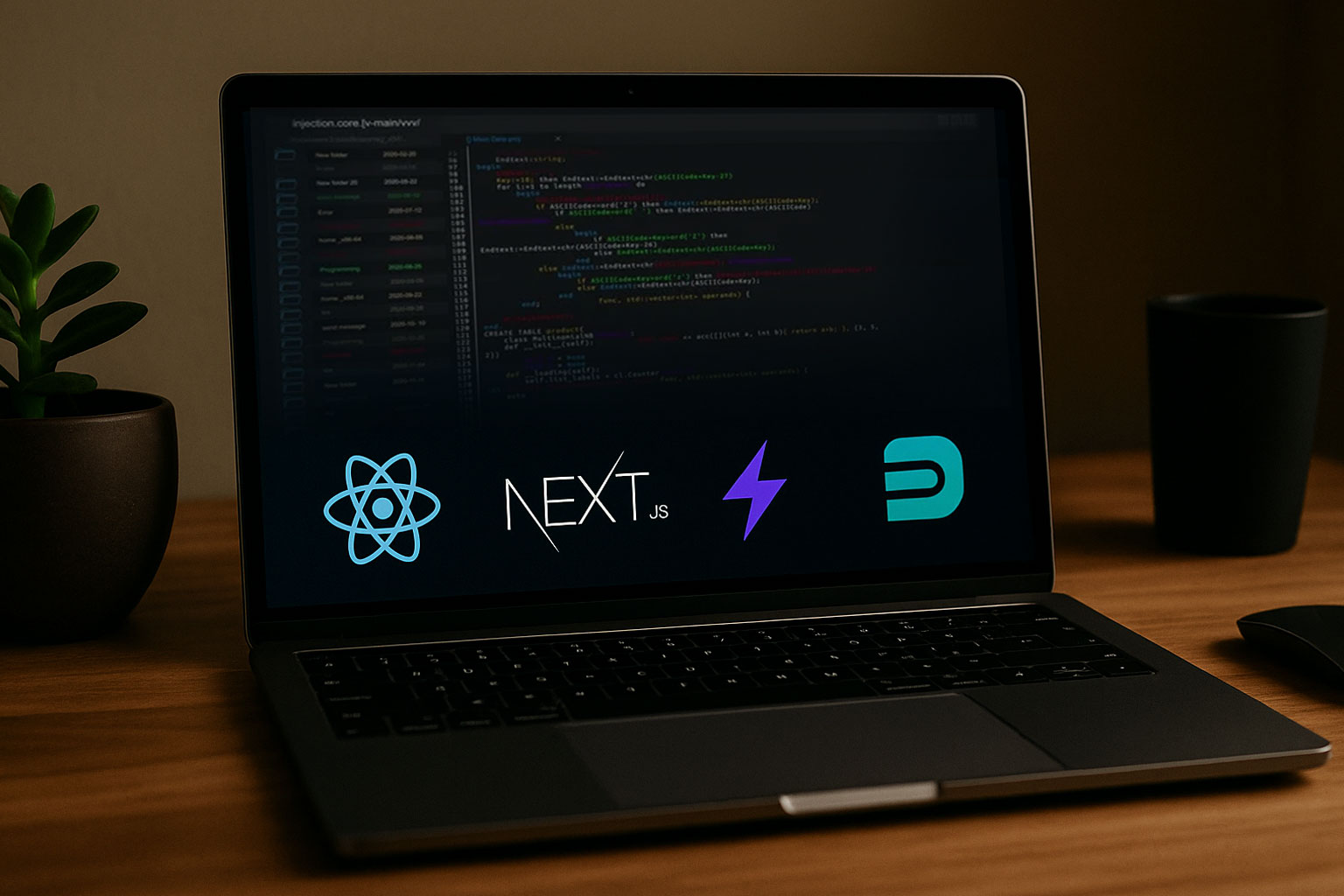Build a Full-Stack React App with Next.js 14, Turbopack & Drizzle ORM: Complete 2025 Guide

14 Oct 2025
Full-stack React development is changing more rapidly in 2025. Next.js 14, combined with Turbopack and Drizzle ORM, gives developers the opportunity to build fast, type-safe, and highly scalable applications nowadays without any hassle.
Even if you are a senior-level engineer or a founder of some startup or even a member of a good professional development team, this is one of the stacks that can help you perform well, be scalable, and provide a user-friendly experience so you can grow in your role.
This blog will assist you in gaining knowledge on how to develop a full-stack React app, the performance of Turbopack vs Webpack, the Drizzle ORM documentation, and develop a modern full-stack development infrastructure that can be deployed to the cloud in 2025.
Why Next.js 14 Is a Game Changer for Full-Stack Development
The Next.js 14 has transformed the traditional ways of development of modern applications.It is not a frontend framework anymore, but a complete, full-stack JavaScript framework that can be used to run enterprise-level web apps.
Core Features That Set Next.js 14 Apart
- Server Components: Server-side rendering components have the potential to reduce the JavaScript load on the client side.
- Turbopack Integration: Next.js has been updated with Turbopack -the new generation bundler replacing Webpack, and with unprecedented build speeds.
- Improved Routing System: Simple and more efficient routing: nested layouts and parallel routing make a large-scale project organization simpler.
- Edge & Middleware Support: Support Powerful native edge deployment, and powerful middleware allows apps to perform incredibly well and flexibly.
Next.js 14 will be the building block of scalable web app construction in 2025, not simply a React framework.
Understanding Turbopack: The Webpack Replacement That Boosts Performance
Webpack has become a relatively well-known tool amongst most developers, especially those who have developed React projects.
But the release of Turbopack in 2025 may bring some exciting changes in the world of bundling.
Turbopack vs Webpack Performance
- 700 times faster development builds.
- 10× faster in production builds
- Low latency with development with immediate HMR (Hot Module Reloading)
This is done with the help of Rust-based architecture and incremental compilation of which only updated modules are recompiled at Turbopack. On large-scale Next.js 14 full-stack projects, it translates to shorter iteration times, increased productivity of developers, and reduced CI/CD build times.
Introducing Drizzle ORM for Type-Safe Database Management
Frontend performance is not sufficient in present applications: it should be reliable, and it should be able to manage type-safe data. Enter Drizzle ORM, a lightweight, TypeScript-first ORM designed for speed and developer experience.
Key Features of Drizzle ORM
- TypeScript-Native: Queries, models, migrations, and everything else are completely type safe.
- Multiple Databases Support: It also assists in many other databases as well such as SQLite and PostgreSQL.
- Automatic Migration: Migrations are triggered and performed automatically when the schema is modified.
- Assurance in Compile Time: The integrity of the program is to make the program more reliable, detect bugs during compilation.
Compared to the more resource-intensive Prisma ORM, Drizzle is a lightweight and better-designed ORM that suits projects that have a heavy performance and scalability emphasis.
Setting Up the Stack: React + Next.js 14 + Turbopack + Drizzle ORM
Ready to build? Here’s a quick setup guide to launch your Next.js 14 full-stack project:
Quick Setup Steps
1. Create a new Next.js 14 project
npx create-next-app@latest my-app
cd my-app
2. Enable Turbopack
next dev --turbo
3. Install Drizzle ORM
npm install drizzle-orm drizzle-kit pg
4. Initialize Drizzle Config
npx drizzle-kit init
5. Create and connect your database
// db/schema.ts
import { pgTable, serial, varchar } from "drizzle-orm/pg-core";
export const users = pgTable("users", {
id: serial("id").primaryKey(),
name: varchar("name", { length: 256 }),
});
Building a Scalable Full-Stack App Architecture
The basic principle on which a scalable web application is based is the separation of concerns, i.e., each of the tiers of your application should have a defined purpose and should be easy to maintain in the event of an increase in the size of the codebase.
The structure of an average full-stack Next.js 14 can be split into the following significant parts:
- App Layer: This is where your core pages, layouts, and server components reside as the frontend interface, as well as backend logic is rendered on the server.
- Components Layer: Buttons and forms, modals, or navigation are all reusable components that are found in their own category to provide consistency throughout the app.
- Library Layer: This part of the project is occasionally referred to as lib and consists of application helper functions, API clients, and utility logic that may be shared by other app parts.
- Database Layer: This is the layer where you can store your Drizzle ORM structures, queries, and logic of communication with the database so that you can communicate with a PostgreSQL database, SQLite, or any other database in the most efficient and type-safe way.
- API Layer: API endpoints and serverless route handlers are found here, which allow the frontend and the backend portions to communicate.
- Assets and Styling: The global stylesheets, theming logic and shared assets such as fonts, icons and pictures are normally stored in particular directories to enable ease in management.
- Configuration: The last step is the configuration that is contained in the next.config.js file and it includes how your application will be configured, optimised and delivered.
This has proven to be an organized manner of ensuring that front-end UI, backend logic, and data management remain modular in such a way that your entire full-stack application is more easily scaled, debugged, and evolved, whether you are deploying an MVP of a startup or something of a more enterprise-grade nature.
Optimizing Performance with Turbopack
Turbopack enables next-generation Next.js 14 performance optimisation techniques in addition to just faster builds:
- Incremental Static Regeneration (ISR): the pages are regenerated upon data change only.
- Code splitting and lazy loading: To achieve faster initial loads, load components as required.
- Edge Caching: lower the latency by making use of serverless functions on a worldwide basis.
The result? Milliseconds-fast load times, even on enterprise load. Cloud-ready next.js apps, even on enterprise load.
Why Businesses Are Choosing Full-Stack React Apps in 2025
The shift in use to modern full-stack development in React and Next.js is happening because of a few reasons:
- Scalability: It serves millions of users, which are easily dynamically scaled.
- Cost Efficiency: Frontend and backend stacks are unified, which minimizes the cost of engineering.
- Faster Time-to-Market: Delivery is accelerated by pre-built components and ready-to-deploy templates.
- Security & Compliance: API routes and middleware, as well as edge functions, are built in to ease compliance.
And it does not have to matter whether you are a startup or a worldwide enterprise; performance, type safety, and scalability are what the enterprise web app development 2025 is all about, and this stack has it all.
How NanoByte Technologies Builds Next-Gen Full-Stack Apps
At NanoByte Technologies, we help companies take their ideas into the clouds on Next.js, which is scaled to apps. We manage the whole life cycle, from the server equipment to the database design, and future-proof it.
What we offer:
- Custom full-stack React application development.
- Turbopack optimization and automation of CI/CD.
- Drizzle database architecture is based on ORM.
- Edge-ready deployment and API-first deployments.
NanoByte Technologies is a reliable technology trendsetter in case you need to outsource Next.js developers or a full-stack development agency.
Start Your Next.js 14 Project with NanoByte Technologies
NanoByte is the viable technology collaborator when you need to employ Next.js developers or a full-fledged development agency.
Start Your Next.js Project Today
FAQs
Q1: Why is Next.js 14 is best for full-stack development?
Next.js 14 will include server components, improved routing, and Turbopack -swifter, more scalable full-stack applications than conventional React applications.
Q2: How does Turbopack improve React app performance?
The Turbopack employs incremental compilation for almost instantaneous rebuilds and is more than 700 times quicker than the development builds. Moreover, it helps in boosting both developers' overall productivity and runtime performance.
Q3: What is Drizzle ORM, and how does it compare to Prisma?
Drizzle can also be used in high-performance applications as an alternative to slower Orms such as Prisma since it is TypeScript-native, compile-time safe, and works with higher-performance migrations.
Q4: How long does it take to build a Next.js 14 full-stack app?
The MVPs can be developed in 4 to 6 weeks, approximately, depending on factors like complexity. On the other hand, enterprise solutions require more than 12 weeks.
Q5: How can I hire expert Next.js developers?
To work with a group of professionals in the creation of Next.js 14 startups and businesses, get in touch with NanoByte Technologies.





